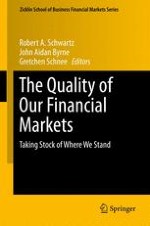
2013 | OriginalPaper | Buchkapitel
1. High-Frequency Trading: Friend or Foe?
verfasst von : Moderator Jim Gatheral, Ari Burstein, Kevin Callahan, Charles-Albert Lehalle, Doreen Mogavero, Lawrence Ryan, L Smith Cameron
Erschienen in: The Quality of Our Financial Markets
Verlag: Springer New York
Aktivieren Sie unsere intelligente Suche, um passende Fachinhalte oder Patente zu finden.
Wählen Sie Textabschnitte aus um mit Künstlicher Intelligenz passenden Patente zu finden. powered by
Markieren Sie Textabschnitte, um KI-gestützt weitere passende Inhalte zu finden. powered by